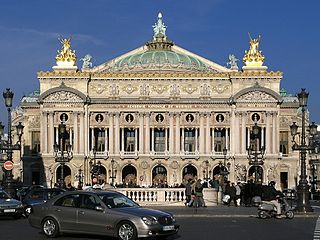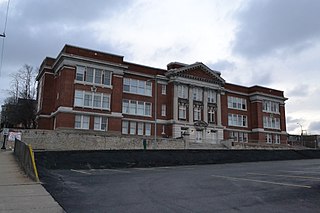
The Robidoux School is a historic school building located at 201 South 10th in St. Joseph, Missouri. It was the first building used by what would become Missouri Western State University. The first high school in St. Joseph was built on the site in 1866. In 1895 the high school moved to 13th and Patee and the building was remodeled to be a grammar school named after St. Joseph founder Joseph Robidoux. In 1907 the building was razed and architect Edmond Jacques Eckel and Walter Boschen was commissioned to design the new Classical Revival style building which opened in 1909 at a cost of $130,000 including contents. It included 12 classrooms and an auditorium seating 1,100. In 1914, the building was used as a freshman annex for Central High School. In 1919 it became the Robidoux Polytechnic High School, a vocational trade school. In 1933 it became home for the St. Joseph Junior College which had been founded in 1915 and was earlier operating out of Central High School. The move occurred at the same time as the Central High School moved to its current location. In 1965 the Junior College became a four-year Missouri Western State College. In 1969 the college moved to its current location on the east side of St. Joseph.
Edmond Jacques Eckel (1845–1934) was an architect in Missouri. One of his firms was Eckel & Mann. Eckel's name has been spelled with variations including Edmund rather than Edmond and with Jacques spelled as Jaques.

City Hose Company No. 9, also known as City Fire Station No. 9 , is a historic fire station located at St. Joseph, Missouri. It was designed by the architect Edmond Jacques Eckel (1845–1934) and built in 1901. It is a picturesque two-story, brick building and features a decorative oriel window.
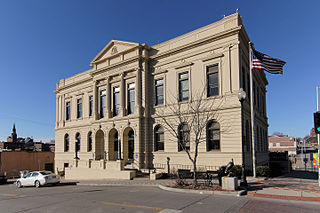
St. Joseph Public Library, also known as Free Public Library, Public Museum, Public Library, and Board of Education Building, is a historic library building located at St. Joseph, Missouri. This library has over 9,000 books. It was designed by the architect Edmond Jacques Eckel (1845–1934) and built in 1901-1902 in the French Baroque style. It is a two-story, brick and reinforced concrete building sheathed in beige marble and limestone. It has a red hipped roof topped by a skeletal glazed dome. It features a pedimented projecting central bay and entrance loggia.

St. Joseph Public Library-Carnegie Branch is a historic Carnegie Library building located at St. Joseph, Missouri. It was designed by the architect Edmond Jacques Eckel (1845–1934) and built in 1902 in the Classical Revival style. It is a one-story, brick and limestone building over a raised basement. It features a projecting front portico with four fluted Ionic order limestone columns. It was built with a $50,000 grant from the Carnegie Foundation.

Edmond Jacques Eckel House is a historic home located at St. Joseph, Missouri. It was designed by the architect Edmond Jacques Eckel (1845–1934) and built in 1885. It is a 2 1/2-story, brick dwelling with a truncated hipped roof. It measures 25 feet wide and 36 feet deep. It features a small, flat roofed, wood entrance portico with Tuscan order columns.
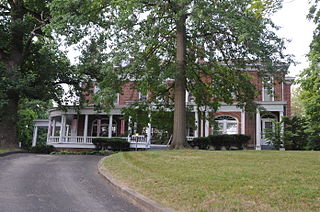
Miller-Porter-Lacy House, also known as the Lacy House, is a historic home located at St. Joseph, Missouri. The original section was built in 1883, as an Italianate style brick farmhouse. It was enlarged and remodeled in 1902 by the architect Edmond Jacques Eckel (1845–1934) in the Colonial Revival / Georgian Revival style. It is a large brick dwelling with a low hipped roof. It features Tuscan order columned porches and a porte cochere. Also on the property is a contributing carriage house and croquet and tennis court sites.

John D. Richardson Dry Goods Company, also known as the American Electric Company, is a historic commercial building located at St. Joseph, Missouri. It was designed by architect Edmond Jacques Eckel (1845–1934) and built in 1892. It is a seven-story, Richardsonian Romanesque style brick and stone building. It measures 196 feet by 136 feet. It features terra cotta faced facades on Jules and Third Street that are detailed with Renaissance derivation motifs.

Livestock Exchange Building is a historic commercial building located at St. Joseph, Missouri. It was designed by architect Edmond Jacques Eckel (1845–1934) and built in 1898-1899. It is a four-story, red brick and stone building with Neoclassical style ornamentation. Also on the property are two contributing multi-car garages and a loading platform. The building was once considered the crown jewel in the vast stockyards and packinghouses on the south side of St. Joseph.

Neely Elementary School, also known as Neely School Building, is a historic school building located at St. Joseph, Missouri. The building was originally constructed in 1871, with its earliest extant portions to date from 1894. Additions and major renovations were completed in 1909 and 1916. The school is a two-story brick and limestone building on a raised basement with Classical Revival style design elements. Some of the modifications were designed by architect Edmond Jacques Eckel (1845–1934).

Cathedral Hill Historic District is a national historic district located at St. Joseph, Missouri. The district encompasses 309 contributing buildings, 1 contributing site, and contributing structures in a predominantly residential section of St. Joseph. It developed between about 1860 and 1950, and includes representative examples of Greek Revival, Italianate, Queen Anne, Colonial Revival, and American Craftsman style architecture. Located in the district is the separately listed Virginia Flats. Other notable buildings include the Nisen Stone House, Thomas Culligan House, A. D. Hudnutt House (1909), St. Joseph Cathedral (1877), James Wall House, Taylor Apartments, E. F. Weitheimer House (1888), Sarah and Ann Walsh Apartment House (1915), Henry Owen Stable (1898), George T. Hoagland Speculative House (1901), and James Hull House (1887).

Harris Addition Historic District is a national historic district located at St. Joseph, Missouri. The district encompasses 288 contributing buildings and 1 contributing site in a predominantly residential section of St. Joseph. It developed between about 1866 and 1940, and includes representative examples of Colonial Revival, Tudor Revival, and American Craftsman style architecture. Notable buildings include the William Payne House (1889), W.C. Green Apartment Building, C.B. Powers House, the Parry-Notter House designed by architect Edmond Jacques Eckel (1845–1934), and a number of speculative houses built by George J. Englehart and W.H. Haynes.
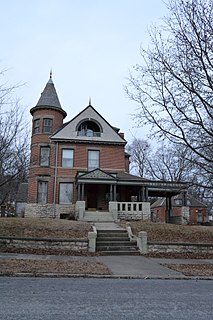
Krug Park Place Historic District is a national historic district located at St. Joseph, Missouri. The district encompasses 28 contributing buildings and 1 contributing site in a predominantly residential section of St. Joseph. It developed between about 1888 and 1938, and includes representative examples of Italianate, Queen Anne, Colonial Revival, Tudor Revival, and American Craftsman style architecture. Notable buildings include the Henry Krug, Jr. House (1892) designed by architect Edmond Jacques Eckel (1845–1934),`A.V. Schaeffer House (1913), W.W. Van Sant House (1914), J.G. Schneider House (1899) by Eckel, Benton Quick House (1901), Mrs. W.B. Watkins House (1903), and George Ward House.

Kemper Addition Historic District is a national historic district located at St. Joseph, Missouri. The district encompasses 74 contributing buildings and 1 contributing site in a predominantly residential section of St. Joseph. It developed between about 1880 and 1950, and includes representative examples of Colonial Revival, Tudor Revival, and American Craftsman style architecture. Notable buildings include the Jacob Spencer House (1912), H. E. Hutchings House (1887), Fred Binz House, Thomas Moseley Duplex (1894), Plaza Apartments (1928-1929), Hickey-Fargrave House with alterations by architect Edmond Jacques Eckel (1845–1934),`C. E. Sprague House (1905) by Eckel, David Bartlett House (1900) by Eckel, and Samuel Nave House (1889).

St. Joseph's Commerce and Banking Historic District is a national historic district located at St. Joseph, Missouri. The district encompasses 39 contributing buildings in the central business district of St. Joseph. It developed between about 1859 and 1950, and includes representative examples of Italianate, Classical Revival, and Streamline Moderne style architecture. Located in the district are the separately listed German-American Bank Building, Corby-Forsee Building, Missouri Theater and Missouri Theater Building, and Missouri Valley Trust Company Historic District. Other notable buildings include the Ballinger Building (1889), Commerce Building, First National Bank of St. Joseph, Lehman's, Plymouth Building (1908), and the United Building (1917-1918) by the architecture firm of Eckel & Aldrich.

Central-North Commercial Historic District is a national historic district located at St. Joseph, Missouri. The district encompasses 18 contributing buildings in an industrial / commercial section of St. Joseph west of the central business district. It developed between about 1885 and 1929, and includes representative examples of Italianate and Classical Revival style architecture. Located in the district is the separately listed John D. Richardson Dry Goods Company. Other notable buildings include a number of warehouse / light manufacturing facilities some of which were designed by the architectural firm of Eckel & Aldrich.
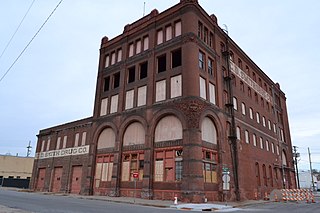
South Fourth Street Commercial Historic District is a national historic district located at St. Joseph, Missouri. The district encompasses 25 contributing buildings in an industrial/commercial section of St. Joseph west of the central business district. It developed between about 1861 and 1929, and includes representative examples of Italianate, Classical Revival, and Renaissance Revival style architecture. Notable buildings include a number of commercial blocks and warehouse/light manufacturing facilities some of which were designed by architect Edmond Jacques Eckel (1845–1934).
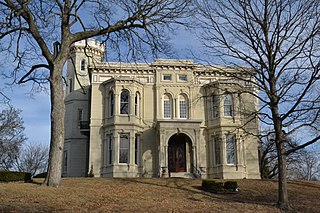
Museum Hill Historic District is a national historic district located at St. Joseph, Missouri. The district encompasses 248 contributing buildings in a predominantly residential section of St. Joseph. It developed between about 1860 and 1942, and includes representative examples of Italianate, Second Empire, Queen Anne, Tudor Revival, American Foursquare, and Bungalow / American Craftsman style architecture. Located in the district is the separately listed Robidoux School. Other notable buildings include the First Congregational Church (1890), Francis Street Methodist Church (1905), First Baptist Church (1896) designed by architect Edmond Jacques Eckel (1845–1934), United Presbyterian Church (1901), First Church of Christ Scientist (1905), First English Evangelical Lutheran Church (1913), and Queen of the Apostles Roman Catholic Church (1908) designed by Eckel.

Wholesale Row, also known as the Wholesale Row Historic District, is a national historic district located at St. Joseph, Missouri. The district originally encompassed five contributing buildings in an industrial / commercial section of St. Joseph on the western edge of the central business district. The Noyes-Norman Building (1872) on 3rd Street has been demolished. It developed between about 1872 and 1884, and includes representative examples of Italianate style architecture. The remaining buildings are the R.L. McDonald and Co. Building (1880), Englehart-Winning Co. North Building (1884), Englehart-Winning Co. South Building (1880), and Brittain-Richardson and Co. Building (1882). The remaining buildings were all designed by the architect Edmond Jacques Eckel (1845–1934).

Samuel and Pauline Peery House is a historic home located at Albany, Gentry County, Missouri. It was designed by the architect Edmond Jacques Eckel and built in 1901. It is a 2 1/2-story, Queen Anne style frame dwelling. It has a hipped roof with hipped dormers. It features a three-story, round tower topped by a bell cast dome and a galleried wraparound porch. Also on the property is the contributing original carriage house.


